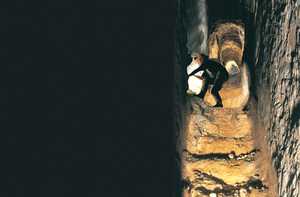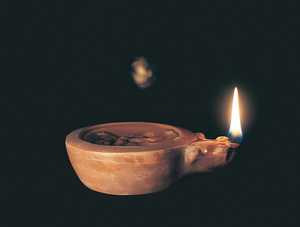gipuzkoakultura.net




It has been calculated that it would have taken four hundred men working for two hundred years to dig the fifteen kilometres of Roman galleries at the Arditurri mine in Oiartzun. These figures may be too high, but there is no doubt that the local silver ore (argentiferous sulphide) was mined intensively during this period. The industry was not confined to Arditurri but also extended to other parts of Gipuzkoa. The archaeological evidence so far indicates that the entire area of Aiako Harria, from Bera de Bidasoa to Irun was worked intensely, and that there were also smaller mines in the areas surrounding Cinco Villas and Udala. As more information comes to light, it is quite possible that most of the many more recent mines in the area - none of which are still active - will prove to have been exploited by the Romans.

There are a number of features that are specific to Roman mines: the galleries are narrow and vaulted, the walls finished off with fine pick-work, and hollows have been left at regular distances for lamps. The floors are well cut and, where there is a slope, stepped to facilitate transport. They are easily distinguished from later, less carefully-built works. Dozens of examples have so far been catalogued, giving us a good idea of planning and working conditions.

In order to locate seams of ore, the Romans first observed the vegetation and surface. They then dug steep shafts down through the upper strata until the vein was met. If no seam was discovered, or if it contained insufficient ore, the shaft was abandoned. If it was judged to be workable, however, a horizontal gallery was then dug for the purpose of extracting the ore and bringing it to the surface. If the seam was big enough, several additional galleries might be built. Where possible the use of shoring-timbers was avoided, as these required that some parts of the seam be left unmined.

The method used for boring the galleries is known as fire-setting was to remain unchanged until the invention of explosives. Wood fires were lit next to the rock, which heated and fractured. A pick-axe was then used to pull out the rock and shape the gallery.
The ore was cleansed of impurities and ground down to select the particles with the highest purity. It was then sifted in pools of water. Smelting was carried out near the mine. Because sulphide is essentially lead with a high silver content, the first smelting process produced a substance in which both lead and silver were still mixed. In a second stage, known as cupellation, the silver was separated from the lead.
We known nothing about the status of the miners; whether they were freemen, serfs or slaves, or whether they were under army control or worked for companies which had obtained mining rights from the state. Archaeological hoards found inside the mines suggest that Aiako Harria was already being mined during the reign of Augustus and that intensive work continued throughout the first century A.D. Subsequently, production may have fallen off or even been abandoned altogether as a result of competition from other more profitable mines. In any case the mines lay forgotten until their rediscovery at the end of the eighteenth century by a German engineer called Johann Wilhelm Thalacker, who had been called in by the Sein family of Oiartzun to resume mining at Arditurri. Thalacker was familiar with the majority of Roman mines in the Iberian Peninsula and in a report published in 1802 he described the features of the galleries, which he considered comparable to those at Cartagena, Leon and Rio Tinto. His report was used extensively by mine-owners seeking mining rights at the end of the nineteenth century who used the original Roman mines to reach previously unworked seams. Unfortunately, this required widening the galleries, which effectively destroyed all ancient remains. In addition, the lead rubble discarded by the Romans was found to contain sufficiently high traces of silver to make it viable to transport it to a new smelter at Capuchinos, in the Bay of Pasaia, and thus an archaeological heritage was lost which would surely have been amongst the most significant historical remains in Gipuzkoa.